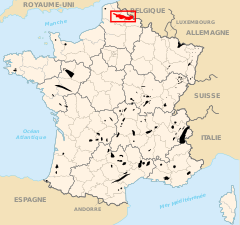North of France coal mining area
The northern French coal mining area (NKR, French Bassin minier du Nord-Pas-de-Calais ) is an area that was shaped by coal mining and is still partly to this day. It extends along the Franco- Belgian border. It has been a UNESCO World Heritage Site since 2012 .
particularities
UNESCO awarded an area of 120,000 hectares with 109 different buildings. These are mines with winding towers , track systems for coal transport, train stations , workers' settlements , schools, churches, company administration buildings, town halls, hospitals and sports facilities. The northern French coal field developed over three centuries; There were special working conditions with dangers underground, unions were formed, town planning was necessary.
history
The first deposits were discovered around 1660 in Boulonnais ( Nord-Pas-de-Calais region ) (later: Mines du Boulonnais ). Coal ("la houille") was first mined in what is now the Pas-de-Calais department .
The search for hard coal began in what is now Département Nord in 1716: Nicolas Desaubois teamed up with Jacques Richard , Pierre Taffin and the brothers Jean-Jacques and Jean-Pierre Desandrouin . At first they opened some seams that were soon exhausted; On February 3, 1720, they found a seam four times as thick as that which had been found up to that point. At the end of 1720 it suffered a water ingress that could not be stopped. Independently of this, it was now known that there was hard coal at Fresnes-sur-Escaut .
Fourteen years later, on June 24, 1734, coal was found in the fosse du Pavé near Anzin (“fosse” means pit, mine ). Several lawsuits were initially carried out for ownership of it until Emmanuel de Croÿ-Solre managed to bring the parties together to form a joint venture and to found the Compagnie des mines d'Anzin on November 19, 1757 . The company grew very quickly. In 1750, mining in the 'Pavé du Nord' area (at a depth of 73 meters) was finally stopped; In 1760 (at a depth of 182 meters) mining in the "Pavé du Sud" area.
Especially since the beginning of industrialization , the steam engine and numerous other inventions have contributed to making coal mining easier and more efficient.
Web links
- Information about the World Heritage on the side of UNESCO (English)
- ( Page no longer available , search in web archives: information on the Charbonnages de France page ) (French)






